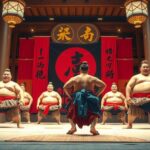Japan’s national sport, sumō, is returning to London in 2025 and Paris in 2026, marking a significant moment as it hasn’t toured internationally since 2013. This comes as a recovery from recent scandals and the pandemic, with hopes of showcasing Japanese culture and reviving fans’ interest. Previous exhibitions have drawn celebrity audiences and robust crowds, making these upcoming events highly anticipated.
Japan’s national sport, sumō, is gearing up for its much-anticipated return to London and Paris, the exhibitions being set for 2025 and 2026, respectively. The London event, set to happen at the iconic Royal Albert Hall, marks the first sumō exhibition since 1991, and the Paris show will be the first since 1995. Enthusiasts in the UK are buzzing with excitement as they await the rare opportunity to witness sumō, a sport with deep roots in Japanese culture.
The 2025 London exhibition is particularly significant, representing the sport’s first international appearance since a 2013 tour that went to Jakarta. Chair of the Japan Sumo Association, Hakkaku, shared his hopes for the event, saying it intends to showcase Japan’s unique culture. Recently, sumō has faced scandals including match-fixing claims and illegal betting, plus COVID-19 disruptions, making this international foray a notable point of recovery for the sport.
Looking back, the last time sumō made waves in London was back in 1991. At the time, the highly-anticipated match featuring future yokozuna Takanohana II had fans on edge, but illness kept him from competing. Instead, the crowd’s focus shifted to Chiyonofuji and the massive Hawaiian-born Ōzeki, Konishiki, who stole the show with his impressive size. The event saw various talents perform, earning it a place in the hearts of London spectators.
The history of sumō in London stretches back to the Meiji era, with a notable exhibition occurring in 1910, showcasing the sport’s international appeal dating back more than a century. Notably, the famous Ōikari was among the wrestlers promoting sumō in the UK during that time. The upcoming events in London and Paris will continue this long-standing tradition of international sumō.
In Paris, sumō has enjoyed two earlier tours, notably in 1986 and 1995. Jacques Chirac, a major supporter of the sport, brought sumō to the French capital as both mayor and later, president. Not without its challenges, the 1995 tournament faced a fire that destroyed the decorative items, but it still rolled on and garnered an impressive audience.
Sumō has piqued interest in the United States since the late 19th century as well, with the legendary yokozuna Hitachiyama introducing it to a crowd that included President Theodore Roosevelt. Despite political tensions leading to a halt in tours between the 1920s and WWII, sumō resumed overseas exchanges by the 1950s, taking on a more diplomatic role.
Since then, sumō has continued to gather international interest, with numerous events featuring celebrity attendees. The likes of King Charles III and Paul McCartney have made their mark at various tournaments, highlighting the global draw of this traditional sport. The upcoming exhibitions in London and Paris will also feature top-ranked rikishi, bringing energy to the events.
As excitement builds for the October tour in London, fans are hoping to see Ōnosato and Kotozakura amongst the competitors. The anticipation is palpable as the rikishi prepare to showcase their skills, promising a traditional spectacle that intertwines sport with Japan’s rich culture. These tours effectively introduce sumō as both a sport and an art, with players serving as ambassadors of Japanese heritage. This year’s London exhibition and the following Paris event promise to attract a diverse audience ready to embrace the ancient sport of sumō.
Sumō’s return to London and Paris marks a significant moment for the sport, as it resumes international tours after a long hiatus. This showcases Japan’s culture and highlights sumō as an important part of its heritage. With rich historical ties to these cities and celebrity endorsements, the upcoming events will likely draw significant attention. Fans eagerly await witnessing top rikishi and the cultural displays that accompany them, aiming to foster closer ties between Japan and the global community.
Original Source: www.nippon.com







